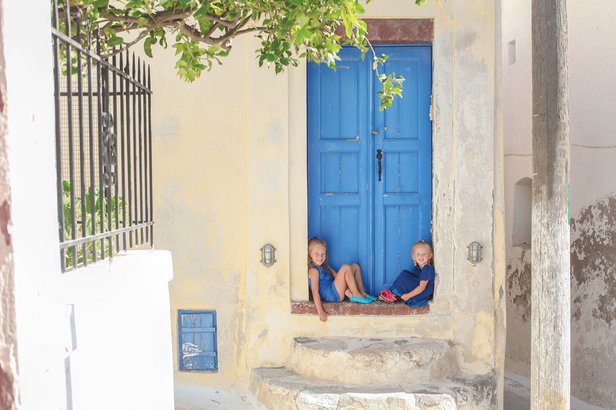
Traveling en famille can get pricey fast. Ever consider house swapping? It not only can save you money, but also lets you live like a local in lodging that's far more family friendly than a cramped hotel room.
Over the past several years my family — my husband and I and our two kids — have traded our home in Seattle's Wallingford neighborhood for a sprawling redwood-and-glass home tucked in the Santa Cruz hills; a condo overlooking the ocean in Baja, Mexico; and a former boarding house in suburban Vancouver, B.C., lovingly restored by its single-family owners.
We first stumbled into home exchange when we lived with our two young children overseas, in Barcelona, Spain; we swapped for flats in Paris, Amsterdam and a tiny French seaside town. When we returned to the States, we simply carried on the tradition. Let’s get to the why and the how.
Why to vacation the home-exchange way
The benefits of home exchange are many. You’re saving a ton of money on lodging so you can splurge on other experiences. You have a kitchen so you don’t have to eat out unless you want to; a washing machine, so you can pack less; and more space (for a still-napping toddler or a privacy-obsessed teen). And, if you swap with a family with similar-age kids (which I highly recommend), they’ll have toys and books that your kids will enjoy exploring. My kids have thrilled in building new (to them) Lego sets, bashing each other with foam swords and finding new favorite books.
You might even hit the jackpot and find a family with a pool or trampoline. After a day of adventure, my kids spent many happy hours bouncing on the Santa Cruz house’s trampoline while my husband and I relaxed with our books and wine amid darting hummingbirds on the terraced redwood deck. We were fully beach-ready, with access to the family’s boogie boards and folding chairs.

The condo in Baja had a pool five steps from our front terrace — the toughest part was tearing the kids away so we could snorkel in the warm water ocean we had traveled so many miles to explore.
The biggest point is that hotel rooms aren’t designed for hanging out; homes are. As you’ve probably learned, kids don’t want to spend every minute sightseeing. With home exchange, your downtime becomes part of the adventure too.
Plus, being connected with locals from the get-go gives you the inside scoop. Past exchange partners have given us invaluable tips on killer tamales, great playgrounds and tucked-away beaches. I've loved being able to play local, hitting farmers’ markets and cooking up the bounty or becoming a temporary regular at the neighborhood coffee shop. You can even swap cars as well, which saves even more.
How to set up an home exchange
We are one of some 60,000 members who pay $9.95 a month to list their home on the online service HomeExchange.com, which bills itself as world'd largest house swap community. In 2014, the top three countries based on membership were the U.S., France and Spain; members complete roughly 130,000 exchanges a year. While Seattle isn’t a top-ranked city (those would be Paris, London, New York, Amsterdam and Barcelona), a HomeExchange.com spokesperson said they have seen Washington State grow in popularity. The company recently launched a “Family-Friendly” collection, featuring more than 30,000 homes deemed suitable for families with children.
As a member, you can search for properties around the world. You also get exchange offers in your inbox. As a travel junkie, I find these both thrilling and agonizing. (“You mean we can’t go to Iceland AND Croatia this August?”).
Generally, we’ve communicated by email with potential exchange partners until we reach a point where it looks like the exchange can work logistically (dates align etc.). Then we schedule a Skype or phone session to “meet” and talk specifics.
My gut plays an important part of this. If I get a bad feeling, I don’t move forward. If all goes well, we finalize the exchange, swap flight itineraries and it’s all systems go. Most exchanges are simultaneous (I’m at your house while you’re at mine). Some are non-simultaneous (I’m at your house in December but you’re coming to mine in August). We’ve done both. To be clear, no money changes hands in an exchange. And it’s based on honesty, trust and respect (more on that in the next section).
Other companies have their own approaches to the swap process, including 3rd Home, which focuses on luxury second homes (and vets your house for inclusion); Love Home Swap, which faciliates not just home swaps but renting and earning points towards home exchange; and Home Link International , which says it’s the oldest exchange group, with the most members outside the United States.
What to know before diving in to home exchange
Lots of people have asked me: “Doesn’t it feel weird to have strangers sleeping in your bed?” Or “Don’t you worry about stealing?”
On the weirdness: If you can't get over it, then home exchange isn’t for you. On stealing: There’s mutual trust at play; you’re in their house, too. And there’s got to be an easier way to burgle than going through the hoops of arranging a home swap. Anything I don’t want people to see or use, I simply hide away in a closet.
You also have to consider the match compatibility (think dating) and look for equitable properties. As we learned the hard way, someone accustomed to living in a luxurious newly built home with a live-in maid isn't going to be happy with our century-old home whose maid service consists of me, my husband and our kids. The listings have photos: If you’re at all concerned about something you see (or something you don’t), best to ask up front.
The proposition is not risk free, but there are ways to mitigate risk. Members often post reviews of their home from prior exchange partners. You can also ask for references from past exchanges. You can use a written home exchange agreement that outlines critical things, such as how keys will be handed over at the start and end, what areas of the home are off limits (if any), and which states that each party will be responsible for any damage. (Yes, we’ve had things broken over the years: our seatbelt, their Christmas snow globe, but nothing irreparable.)
If a host has to cancel, they’re expected to make every effort to accommodate or find accommodations for their exchange partner. Though rare, cancellations do happen. (Thus far, not to us.) In 2014, HomeExchange.com said they got 101 cases of members reporting cancelled exchanges (out of about 130,000 exchanges). In most cases, company representatives say, travelers were able to find alternative accommodation (some with the help of HomeExchange.com). But the company does not assume responsibility for cancellations or provide any sort of insurance against it.
Lastly, home exchange is work: Researching a good match; multiple emails and phone calls; cleaning your home top to bottom, putting those special toys away (my daughter was distraught after some young houseguests stripped her American Girl doll; the doll now goes away for exchanges); making space for visitors’ things in drawers and closets; writing a home and neighborhood guide; explaining to the neighbors.
But it’s work that, for our family, has paid off in unforgettable travel experiences.











